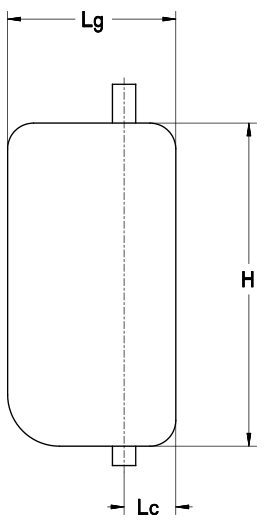For boats equipped with a hydraulic steering, it will be necessary to determine:
– The volume of the steering cylinder (take the biggest volume in case of a single rod cylinder)
– Available voltage on board (12 VDC, 24 VDC, etc.)
For planing or semi-planing hulls, the power pack will be selected in function of its flow rate so that the steering cylinder will run its complete stroke within 10 to 12 seconds.
For displacement hulls, the power pack flow rate must enable the steering cylinder to run its complete stroke within 15 to 17 seconds.
Examples:
- Speed boat, planing hull with a 239 cc cylinder – Available voltage 12 VDC60 seconds (1 minute)
—————————-
12 seconds (required time) x 0.239 litre (239 cc) = 1.195 litre / minute
The flow rate of the required power pack will be 1.19 litre / minute, therefore we will select a reversible power pack with adjustable flow rate type RV2 (12 V) - Fishing or work boat, displacement hull with a 2,307 cc cylinder – Available voltage 24 VDC60 seconds (1 minute)
—————————-
15 seconds (required time) x 2.307 litre (2307 cc) = 9.228 litre / minute
The flow rate of the required power pack will be around 9 litres / minute, therefore we will select a power pack type HF 1.5 – 9 (24 V)
For boats equipped with a mechanical steering (wire ropes, cables, rack and pinion), it will be necessary to determine:
– The rudder(s) torque
– The available voltage on board (12 VDC, 24 VDC, etc.)
Torque Calculation:
For boats fitted with a rudder with speed not exceeding 25 knots, the torque (C) of the rudder or rudders will be calculated according to the formula and correction coefficients below:
C = S x [ (0.4 Lg) – Lc ] x V² x K
C = Torque in kpm
S = Total surface of rudder (H x Lg) in sq. m
H = Height of rudder in m
Lg = Width of rudder in m
Lc = Compensation width in m
V = Maximum speed of the boat in knots
K = Coefficient according to total angle of rudder
| Port to starboard | 70° | K = 15.89 |
| Port to starboard | 80° | K = 17.80 |
| Port to starboard | 90° | K = 19.52 |

| Corrections in function of the type of boat: | |
|---|---|
| For sailing-boats | C x 0.5 |
| For boats fitted with several rudders (catamarans, trimarans, monohulls) | multiply the calculated torque result by the number of rudders fitted on the boat |
| Examples: | |
| H = 1.2 m | Speed under sail = 12 knots |
| Lg = 0.7 m | Speed with motor = 8 knots |
| Lc = 0.18 | S = 1.2 x 0.7 = 0.84 m2 |
| Torque under sail = (0.84 x [(0.4 x 0.7) – 0.18] x 122 x 15.89) x 0.5 = 96.11 m.kg | |
| Torque with motor = 0.84 x [(0.4 x 0,7) – 0.18] x 82 x 15.89 = 85.42 m.kg | |
| Selection of the linear drive: | |
|---|---|
| Torque not exceeding 50 kpm | Linear drive type 32ST16 NEWAVE |
| Torque not exceeding 100 kpm | Linear drive type 40ST16 NEWAVE |
| Torque not exceeding 200 kpm | Linear drive type 50ST20 NEWAVE |
| Torque not exceeding 390 kpm | Linear drive type 63ST28 DEBP NEWAVE |
In the above example, the calculated torque is 96.11 kpm. Therefore the correct selection will be a linear drive type 40ST16 NEWAVE.
Note : for sailing boats with a modern hull and balanced rudder, the selection can be made in function of the boat length as below:
| Length | Linear drive type |
|---|---|
| Length not exceeding 33 feet | 32ST16 NEWAVE* |
| Length not exceeding 44 feet | 40ST16 NEWAVE* |
| Length not exceeding 60 feet | 50ST20 NEWAVE* |
| Length not exceeding 80 feet | 63ST28 DEBP NEWAVE* |
*Data given as an indication only
